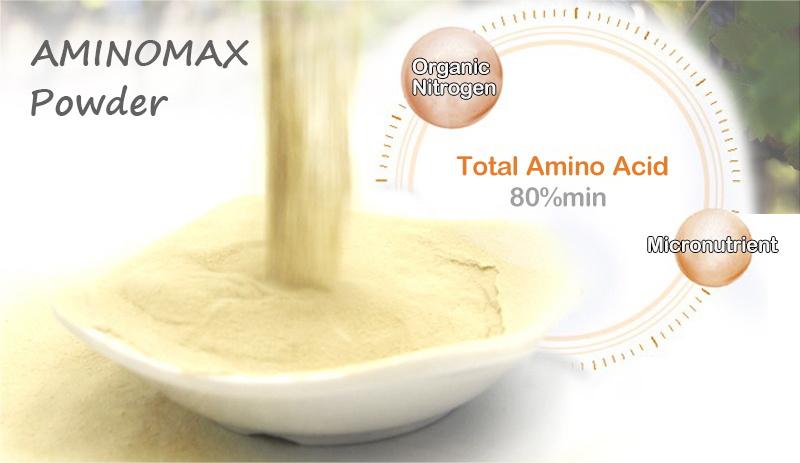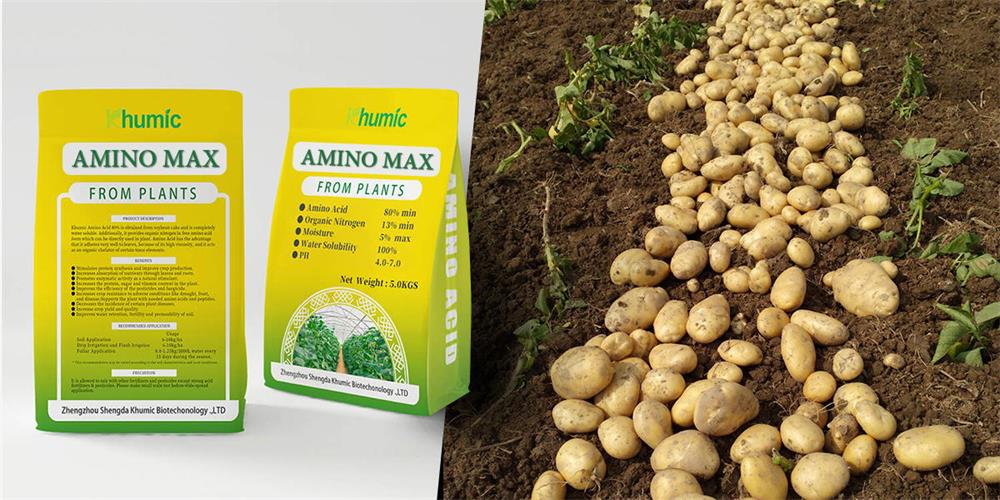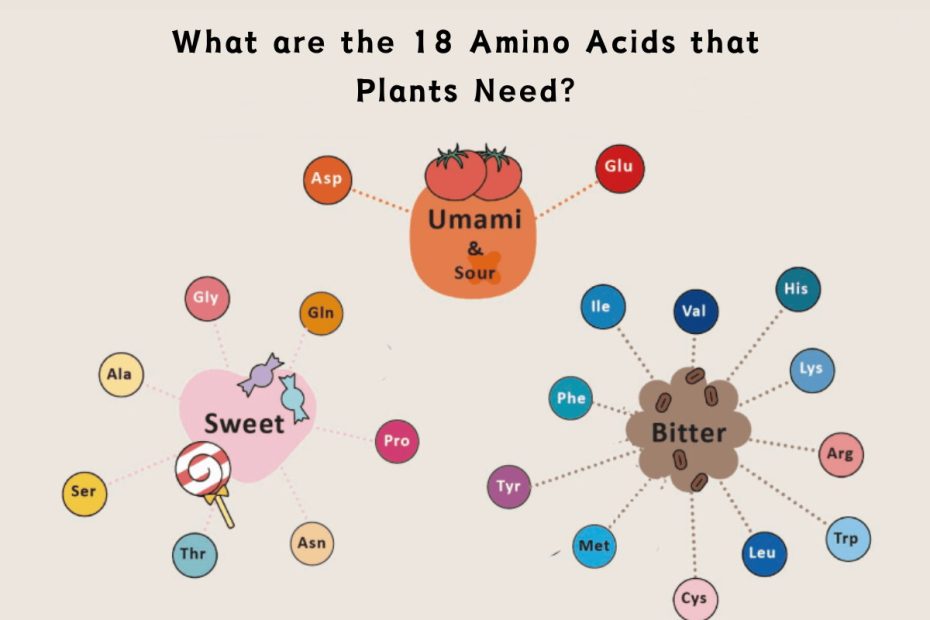Introduction
Much like humans and animals, plants require a specific set of nutrients to thrive. Amino acidsAmino acids play an important role in plant development and stress defense and are the building blocks of enzymes, hormones, and proteins. Amino acids are involved in processes such as photosynthesis, nutrient absorption, hormone synthesis, and stress response. There are 20 standard amino acids, 18 of which plants require to support their growth and development. These amino acids are divided into two categories: essential amino acids, which plants cannot synthesize on their own and must obtain from external sources; and non-essential amino acids, which plants can produce internally.
Table of Contents
Properties and Characteristics of 18 Amino Acids in Plants
Glycine
Glycine is a non-polar, colorless, sweet-tasting, basic amino acid with the smallest molecular weight. It can be used as a raw material for growth hormones, plays an important role in protein synthesis, and participates in the growth and development of plants. Applying glycine to crops can promote the growth of crops and increase growth indicators such as plant height, stem thickness, and leaf area. Glycine can increase crops’ stress resistance, improve crops’ ability to adapt to adversity, and has biological activities such as moisturizing, anti-oxidation, and antibacterial.
Alanine
Alanine is a colorless, sweet, and highly stable water-soluble amino acid. It has the functions of increasing chlorophyll synthesis, regulating the opening of stomata, and resisting pathogens. It can promote plants’ growth and development and enhance plants’ resistance to stress.
Citation source: https://www.sohu.com/a/545500266_379553
Arginine
Arginine is a colorless crystal with optical activity and is one of the basic amino acids. It is a precursor for the production of cytokinins, which can promote the synthesis of various hormone polyamines in plants and is used as a synergist in fertilizers. It strengthens root development and promotes plant growth, development, and reproduction. It has biological activities such as antioxidant, and antibacterial, improving the ability of crops to resist salt stress and regulating plant hormone synthesis.
Aspartic acid
Aspartic acid is a white crystal with optical activity and is a polymer of amino acids. It has certain biological activities and is important in protein synthesis, promoting plant nitrogen metabolism, improving plant stress resistance, regulating plant hormone synthesis, and other biological activities. Aspartic acid can improve seed germination, protein synthesis, and provide nitrogen for growth during stress periods, promote leafy vegetable crops to absorb the original or applied N, P, and other nutrients in the soil, thereby increasing the growth rate and yield of leafy vegetable crops; enhance the ability of plants to absorb N and P elements around the roots to purify the soil environment and water environment.
Cysteine
Cysteine is an optically active white crystal amino acid containing sulfur atoms. It plays an important role in protein synthesis and has biological activities such as antioxidant, antibacterial, and regulation of plant hormone synthesis. It participates in seed germination, root growth, leaf senescence, and programmed cell death of vessel molecules in stems and tapetum cells in anthers.
Asparagine
Asparagine is an optically active white crystal and an amino acid containing an amide group. It can be used as a form of nitrogen storage and transportation in plants to promote nitrogen and energy metabolism. Asparagine promotes cell proliferation and has outstanding functions in plant growth, development, and defense.
Glutamic acid
Glutamic acid is an optically active white crystal that plays an important role in protein synthesis and can promote plant nitrogen and energy metabolism processes, and improve plant stress resistance and other biological activities. Glutamic acid is mainly present in mitochondria and is involved in seed germination, root structure, pollen germination, and pollen tube growth. It has a certain ability to protect the root system of plants and will form a protective film to protect the root hairs of plants. Under stress conditions, glutamate can participate in wound response, pathogen resistance, response and adaptation to abiotic stresses (such as salt, cold, heat, and drought), and long-distance signal transduction triggered by local stimuli (abiotic or biotic stress).

Glutamine
Glutamine is a colorless crystal with optical activity. It is an amino acid containing an amide group. Glutamine is the most important nitrogen carrier in plants and an important form of nitrogen storage in plants. It participates in nitrogen metabolism and energy metabolism and has biological activities such as promoting plant growth and enhancing plant stress resistance. When the ammonium ion concentration in plants is high, glutamine is synthesized in large quantities to prevent ammonium ion accumulation and poisoning. Glutamine is not only used by cells to synthesize proteins but also to transport ammonia.
Histidine
Histidine is a colorless crystal, optically active, amino acid containing an imidazole group. It can serve as a precursor for various alkaloids in plants and has antioxidant properties, as well as the function of a metal ion chelator and transporter. Histidine is involved in the biosynthesis of important compounds such as histamine, carnosine, and hemoglobin, and is essential for plant growth and development. In addition, histidine is a key component of metal-binding proteins and enzymes, contributing to their normal function in plant metabolism.
Isoleucine
Isoleucine is a white or slightly yellow crystal with optical activity and is one of the branched-chain amino acids. It plays a vital role in protein, plant hormones, and overall plant growth and development. Isoleucine also helps plants respond to stress, enhances plant resistance, and helps maintain plant health and resilience.
Leucine
Leucine is an optically active white crystal, a branched-chain basic amino acid that can participate in acid-base reactions and regulate the acid-base balance in plants. Leucine plays an important role in protein synthesis and has the functions of promoting plant growth, enhancing plant stress resistance (such as resistance to environmental stress such as cold and drought), regulating plant hormone synthesis, and improving crop quality. It increases plant height, leaf area, and biomass of crops.
Lysine
Lysine is a colorless crystal with optical activity and is one of the basic amino acids. Lysine plays an important role in protein synthesis and can promote plant growth, enhance plant stress resistance, regulate plant hormone synthesis and other biological activities. It participates in various metabolic processes, including nitrogen metabolism and cell wall formation. It is also important for the production of enzymes and hormones. In addition, lysine is a key component in the biosynthesis of secondary metabolites and plays a role in plant defense mechanisms.
Methionine
Methionine is an optically active white crystal and is the only amino acid containing a methyl group (-CH3). It can serve as a precursor for the synthesis of important molecules such as ethylene, polyamines, and other sulfur-containing compounds that are essential for plant growth, development, and stress response. Methionine plays an important role in protein synthesis and various metabolic processes and is involved in the regulation of gene expression, signal transduction pathways, and defense mechanisms against environmental stressors. Availability and metabolism are strictly regulated to ensure that plants function properly and adapt to changing environmental conditions.
Phenylalanine
Phenylalanine is a colorless crystal with optical activity and is one of the aromatic amino acids. Phenylalanine plays an important role in protein synthesis and is a precursor of various important compounds in plants, such as flavonoids, lignin and other phenolic compounds. It has biological activities such as signaling pathways, antioxidants, and antibacterials. It helps in plant pigmentation, UV protection, and defense against pathogens and herbivores. Lignin, a derivative of phenylalanine, provides structural support for plant cell walls and contributes to the overall strength and rigidity of the plant.
Proline
Proline is a colorless crystal with optical activity. It is the only amino acid with a ring structure. Proline can act as an osmotic regulator in plants to enhance their stress resistance. It also has biological activities such as protecting the integrity of plant cell membranes and regulating plant hormone synthesis. It helps plants tolerate stress conditions such as drought, salinity, and extreme temperatures. In addition, proline is also involved in maintaining cell structure and function under adverse environmental conditions.
Serine
Serine is a white crystal with optical activity and is one of the neutral amino acids. It participates in various metabolic pathways and is essential for the biosynthesis of proteins, nucleotides, and other important molecules. In addition, serine is a precursor for the synthesis of other amino acids such as glycine and cysteine.
Threonine
Threonine is a colorless crystal with optical activity. It is a neutral amino acid necessary for protein synthesis and various metabolic processes. It has biological activities such as improving plant stress resistance and promoting nitrogen metabolism.
It also acts as a precursor for the biosynthesis of important molecules such as glycine and serine. It helps maintain cell structure and function, as well as regulate plant growth and development. In addition, threonine participates in the stress response and defense mechanism of plants, contributing to the overall resilience of plants and adaptation to environmental challenges.
Valine
Valine is an optically active white crystal that participates in protein synthesis and energy production and is one of the branched-chain amino acids. It plays an important role in protein synthesis and has biological activities such as promoting plant root development, enhancing plant stress resistance, and promoting nitrogen metabolism. In addition, valine can serve as a precursor for other important molecules in plants, and its presence is essential for the normal functioning of plant cells and tissues.
Ensuring Optimal Plant Health
Plants require 18 amino acids to perform important biological functions. If plants are unable to absorb enough essential amino acids from the soil or environment, adding amino acid fertilizers or supplements may be beneficial. These supplements can help fill nutritional gaps, support the plant’s metabolic processes, and promote overall health and vitality.
KHUMIC’s amino acid fertilizer is a plant resource that is Cl-free. It is 100% soluble and rich in 18 amino acids. It can be directly absorbed by the leaves, providing organic nitrogen to the plant and improving yield. It increases crude protein, soluble sugars and protein content in food crops, improves quality, and provides a balanced diet for plants. Maintaining a careful balance of nutrient supply is essential to supporting plant health and productivity.

Conclusion
Understanding the significance of amino acids in plant growth is key to fostering healthy and thriving greenery. By ensuring that your plants receive the necessary 18 essential amino acids, you can promote robust growth, vibrant foliage, and bountiful harvests.
FAQ
Why are amino acids important for plant growth?
Amino acids are the building blocks of proteins and play crucial roles in various metabolic pathways within plants, including growth, development, and stress responses.
Can plants produce all amino acids by themselves?
Plants can synthesize some amino acids, known as non-essential amino acids, while others, essential amino acids, must be obtained from the environment.
How can I ensure my plants get enough amino acids?
Providing a balanced nutrient solution, incorporating organic matter, and maintaining optimal growing conditions can help ensure that plants receive an adequate supply of amino acids.
What are some signs of amino acid deficiency in plants?
Symptoms of amino acid deficiency in plants may include stunted growth, yellowing of leaves, reduced fruit or flower production, and increased susceptibility to pests and diseases.
Are there specific amino acid supplements available for plants?
Yes, KHUMIC has an amino acid supplement specifically designed for plants that provide 18 amino acids to provide additional support for plant growth, development, and tolerance to stress.
